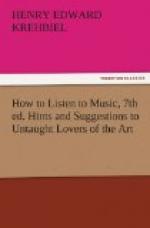Yet in the realm of another sense, in the contemplation of beauties more ethereal and evanescent than those of nature, such is the experience which in my capacity as a writer for newspapers I have made for many years. A party of people blind to form and color cannot be said to be well equipped for a Swiss journey, though loaded down with alpenstocks and Baedekers; yet the spectacle of such a party on the top of the Rigi is no more pitiful and anomalous than that presented by the majority of the hearers in our concert-rooms. They are there to adventure a journey into a realm whose beauties do not disclose themselves to the senses alone, but whose perception requires a co-operation of all the finer faculties; yet of this they seem to know nothing, and even of that sense to which the first appeal is made it may be said with profound truth that “hearing they hear not, neither do they understand.”
[Sidenote: Popular ignorance of music.]
Of all the arts, music is practised most and thought about least. Why this should be the case may be explained on several grounds. A sweet mystery enshrouds the nature of music. Its material part is subtle and elusive. To master it on its technical side alone costs a vast expenditure of time, patience, and industry. But since it is, in one manifestation or another, the most popular of the arts, and one the enjoyment of which is conditioned in a peculiar degree on love, it remains passing strange that the indifference touching its nature and elements, and the character of the phenomena which produce it, or are produced by it, is so general. I do not recall that anybody has ever tried to ground this popular ignorance touching an art of which, by right of birth, everybody is a critic. The unamiable nature of the task, of which I am keenly conscious, has probably been a bar to such an undertaking. But a frank diagnosis must precede the discovery of a cure for every disease, and I have undertaken to point out a way in which this grievous ailment in the social body may at least be lessened.
[Sidenote: Paucity of intelligent comment.]
[Sidenote: Want of a model.]
It is not an exaggeration to say that one might listen for a lifetime to the polite conversation of our drawing-rooms (and I do not mean by this to refer to the United States alone) without hearing a symphony talked about in terms indicative of more than the most superficial knowledge of the outward form, that is, the dimensions and apparatus, of such a composition. No other art provides an exact analogy for this phenomenon. Everybody can say something containing a degree of appositeness about a poem, novel, painting, statue, or building. If he can do no more he can go as far as Landseer’s rural critic who objected to one of the artist’s paintings on the ground that not one of the three pigs eating from a trough had a foot in it. It is the absence of the standard of judgment employed in this criticism which makes significant talk about music so difficult. Nature failed to provide a model for this ethereal art. There is nothing in the natural world with which the simple man may compare it.




